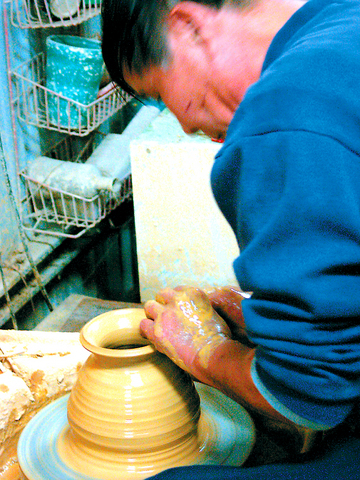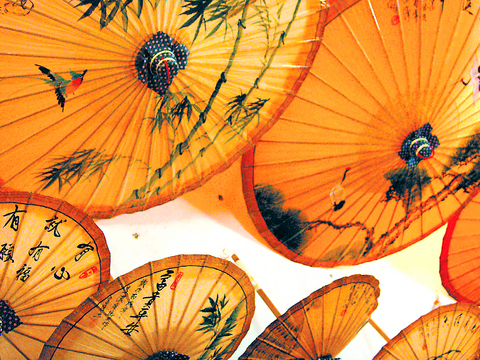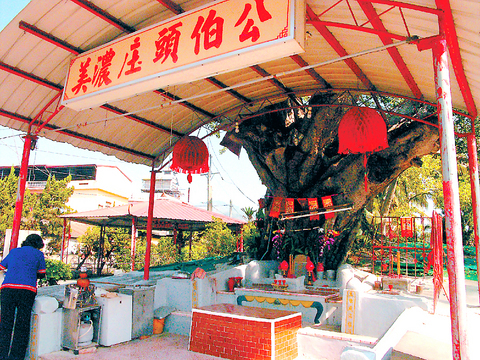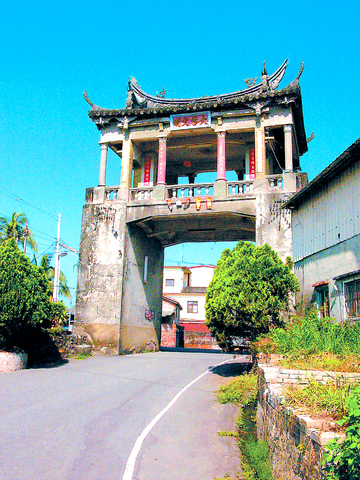Surrounded by mountains, with lakes and babbling brooks to boot, Meinung (美濃) is the ideal getaway spot. The Hakka town boasts more than just scenic beauty -- the hardworking, familial spirit of traditional Hakka culture also imbues Meinung with oodles of charm.
The heart of Meinung's traditional Hakka culture is concentrated on the town's main street, Yungan Road (
Bicycling is an excellent way to take in Meinung's sights. Seven paths, each color coded, are currently open to cyclists. The red line is devoted to cultural relics, the green line has a literary theme, and the blue line offers charming views of the irrigation canals that crisscross the landscape. The far-off silhouettes of mountains, the expanse of rice paddies, and the inverted, watery reflections of Chungcheng Lake (中正湖) have enchanted travelers for years. The delicious Hakka cuisine keeps visitors coming back.

PHOTOS: WU MENG-FANG, TAIPEI TIMES
Blue Hakka tunics
Blue tunics are a Hakka cultural mainstay. In the past, most Hakka women donned the baggy, loose blouse. The tunics were worn until they became dog-eared and tattered, and only then would new ones be bought -- a testament to the Hakka work ethic and their thriftiness. The versatility of the traditional tunic also extended to when one could wear it -- always. Loose-fitting and practical, the tunic was appropriate in both formal and informal circumstances, and comfortable in all seasons.
Of course, the popularity of the tunic has faded: Now Meinung residents rarely wear it, save for at Hakka cultural performances and other special occasions. As a result, Hakka tunic shops have all but disappeared. However, one shop still holds tenaciously to tradition, with its old-style tailoring services and handmade tunics. The Chinhsing Blue Tunic shop (錦興藍衫店) on Yongan Street is the last of its kind. Hsieh Ching-lai (謝景來), a spry nonagenarian, is still behind the scissors in his shop after more than 70 years of fashioning tunics. He was apprenticed at 17 and launched his own tunic-making business in his 20s. At the height of his business, Hsieh taught his trade to over 200 students. Later, however, the rising popularity of Western fashions affected the blue Hakka tunic industry. Although the tunics are not fancy, they are meticulously made and are high quality.

■ Price: NT$2000 per tunic
■ Can be custom-made in about two weeks
■ Chinhsing Blue Tunic Shop telephone: (07) 681 1191

Oilpaper umbrellas
Some folks believe that umbrellas make unlucky gifts. In Meinung, however, umbrellas are elegant, auspicious objects. Oilpaper umbrellas are Meinung's specialty. Moreover, a play on words makes these paper parasols especially propitious. The Chinese words for "paper" (
Hakka oilpaper umbrellas were once practical necessities. Now, such parasols are considered more decorative than useful; nevertheless, they remain popular as mementos of trips to Meinung. Although the umbrellas are fashioned from simple materials like cotton paper, bamboo and twine, the production process is complicated. The bamboo is first boiled in water to leech the sugar from its core, after which it is cut into strips that are to be the umbrella's spokes. Once the spokes are attached to the shaft of the umbrella, concentric circles of twine are added. Then, the cotton paper is fastened to the umbrella's "skeleton." The paper is then decorated with colorful illustrations of natural landscapes, mythical creatures, or other traditional images. Finally, the umbrella is varnished and set out in the sun to dry.

Of course, even today's oilpaper umbrellas retain their practical uses. They still keep folks more or less dry in the rain, but although they're water resistant, they're particularly susceptible to fire. Also, they become brittle if not used regularly, and the oilpaper tends to stick to itself if the parasol remains closed for an extended period.
Pottery
A small pottery and ceramics industry sprung up in 1987, when local artist Chu Bang-hsiung (
Potters set up work shops, and seven ceramics shops in the kiln's vicinity. Slowly but steadily, Meinung gained recognition as a center of the ceramic arts. The shops retail a wide variety of ceramics, and although more rustic than sophisticated, they encapsulate the unpretentious spirit of Meinung culture.
Local delicacies: Bantiao noodles
A trip to Meinung wouldn't be complete without sampling bantiao noodles. Made from aged tsailai rice (
■ Meinung Chuang telephone: (07) 681 8989
Sightseeing in Neimen
Separated from the Meinung Township (美濃鎮) by Chishan (旗山鎮) and Shanlin (杉林鄉) townships, Neimen township (內門鄉), on Highway 3 (
Locals with a big stake in the future, from soon-to-be-wed couples to political candidates, often converge on Neimen's famous Tzuchu Temple (
Tzuchu Temple is the religious center of Neimen. The village hosts performances that combine mock martial arts battles and dance, which are performed by costumed acrobatic troupes. The Songjiang Battle Array (宋江陣) is the most popular of these spectacles. In addition to the traditional battle arrays, Kaohsiung County Government also hosts the Creative Battle Array Competition (創意宋江陣), an annual nine-day contest that attracts hordes of enthusiasts.
In addition to its cultural attractions, Neimen's landscape also contributes to its uniqueness. The eerie Moon World (月世界), a barren landscape covering 100,000 hectares, encircles Neimen with its strange, denuded mountains. Moon World's infertile soil is known in geological terms as "mudstone," originally a clay-like, ocean-floor sediment dredged up on the backs of mountains that were formed through orogenic movement.
Over millions of years the soil was eroded by the elements, becoming mudstone, which is too salty, dry and loose to sustain vegetation.
As its name suggests, Neimen's Moon World, in the vicinity of the 29-kilometer marker on County Road 182 (182
The view from Hill 308, where the townships of Neimen, Lungchi (

June 23 to June 29 After capturing the walled city of Hsinchu on June 22, 1895, the Japanese hoped to quickly push south and seize control of Taiwan’s entire west coast — but their advance was stalled for more than a month. Not only did local Hakka fighters continue to cause them headaches, resistance forces even attempted to retake the city three times. “We had planned to occupy Anping (Tainan) and Takao (Kaohsiung) as soon as possible, but ever since we took Hsinchu, nearby bandits proclaiming to be ‘righteous people’ (義民) have been destroying train tracks and electrical cables, and gathering in villages

Swooping low over the banks of a Nile River tributary, an aid flight run by retired American military officers released a stream of food-stuffed sacks over a town emptied by fighting in South Sudan, a country wracked by conflict. Last week’s air drop was the latest in a controversial development — private contracting firms led by former US intelligence officers and military veterans delivering aid to some of the world’s deadliest conflict zones, in operations organized with governments that are combatants in the conflicts. The moves are roiling the global aid community, which warns of a more militarized, politicized and profit-seeking trend

The wide-screen spectacle of Formula One gets a gleaming, rip-roaring workout in Joseph Kosinski’s F1, a fine-tuned machine of a movie that, in its most riveting racing scenes, approaches a kind of high-speed splendor. Kosinski, who last endeavored to put moviegoers in the seat of a fighter jet in Top Gun: Maverick, has moved to the open cockpits of Formula One with much the same affection, if not outright need, for speed. A lot of the same team is back. Jerry Bruckheimer produces. Ehren Kruger, a co-writer on Maverick, takes sole credit here. Hans Zimmer, a co-composer previously, supplies the thumping

Dr. Y. Tony Yang, Associate Dean of Health Policy and Population Science at George Washington University, argued last week in a piece for the Taipei Times about former president Ma Ying-jeou (馬英九) leading a student delegation to the People’s Republic of China (PRC) that, “The real question is not whether Ma’s visit helps or hurts Taiwan — it is why Taiwan lacks a sophisticated, multi-track approach to one of the most complex geopolitical relationships in the world” (“Ma’s Visit, DPP’s Blind Spot,” June 18, page 8). Yang contends that the Democratic Progressive Party (DPP) has a blind spot: “By treating any